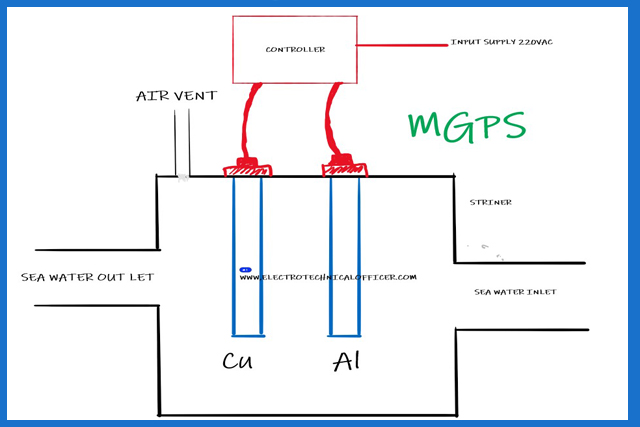Shore Power
Shore supply is used mainly during dry dock when alternator have to overhaul
Nowadays shore power is used for
emission control in ports
Introduction
Generally, shore connection box
is provided in the emergency generator room. The shore connection box connects,
via a moulded case circuit breaker (MCCB) on the emergency switchboard, to the
main switchboard disconnecting switch panel, where an air circuit-breaker (ACB)
connects it to the main switchboard bus bar.
When onshore power, the
emergency switchboard can be supplied as normal through the main/emergency
switchboard bus tie circuit-breakers.
Monitoring lamps for SHORE ALIVE
and SHORE MCCB CLOSED are located on the main switchboard synchronizing panel,
and a voltmeter and ammeter with the facility to monitor the shore voltage and
current is located on the main switchboard.
A frequency meter, ammeter, and
voltmeter are located on the emergency switchboard, emergency generator panel
with the facility to monitor the shore supply frequency, current, and voltage.
A phase sequence monitoring
system, watt-hour meter, and SHORE ALIVE, SHORE MCCB CLOSED, and SHORE MCCB OPEN
indicators are fitted at the shore connection box on the emergency switchboard.
The phase sequence should be
checked before connecting shore power to the switchboards. When the shore
supply has been connected at the box, it should be switched on ashore and the
PHASE SEQUENCE TEST push-button pressed. If the phase sequence is incorrect the
shore supply must be isolated and two supply phases changed over. The supply
should then be reinstated and the phase sequence checked again.
The watt-hour meter is provided
to measure and record the power consumed by the vessel when onshore supply.
Interlocking is provided between
the ship’s main generator ACBs and the shore supply breaker. The shore supply
breaker cannot be closed if any generator ACB is closed. Conversely, none of
the ship’s generator ACBs can be closed if the shore supply breaker is closed.
This arrangement prevents the shore supply from being paralleled with any other
supply.
Components of shore connection box
Data plate- it contains ship’s
working voltage, frequency, and instruction for shore connection.
Voltmeter
Frequency meter
Phase sequence indicator
Wattmeter
Indication lamps
Circuit breaker and fuses
Pre checks before connection of shore power
Check the shore connection root
hatch cover for freeness and obstructed with any object.
Make sure the receiving terminals
are good in order.
Check the indication lamps
Make sure the ship’s batteries
are fully charged.
Checks during shore connection
Check the shore power cable
condition
Carry out megger test for shore
power cable.
Connect the shore power cables
into the shore power box in the emergency generator room via the given way.
Make sure the earthing cable
arranged to shore earthing to the ship’s hull.
Note down and take the pictures
of shoreside wattmeter readings and ship wattmeter readings.
Switch on the shoreside power.
Confirm the SHORE ALIVE indicator lamp is illuminated at the shore connection
box.
Ensure the voltage, and frequency
of the shore supply with ship rated voltage, and frequency.
Check the phase sequence is
correct.
Procedure for the Operation of Shore Power Reception
Isolate the emergency generator
to ensure that it does not start.
Isolate all non-essential
services. Reduce load at the main switchboard to the absolute minimum.
Turn the GEN CONTROL selection
switches on the main switchboard generator panels to the MANUAL position. This
is to ensure that no main generators start when the vessel blacks out.
At the main switchboard, open all
the generator ACBs. The vessel blacks out.
Close the breaker for shore power
at the shore connection box.
The bus tie at the main
switchboard disconnecting switch panel is not fitted with an
Undervoltage trip and will therefore remain closed upon the loss of power. The
shore power will therefore now be supplying the main switchboard.
Proceed to supply essential
services as necessary.
If no maintenance is scheduled
for the emergency generator, it may be left on automatic standby. The emergency
generator will then feed emergency lighting, etc, in the case of failure of the
shore supply.
The shore supply should be
closely monitored to ensure the rated current limit is not exceeded.
Procedure for Transfer from Shore Supply to Main Diesel Generator
Isolate all non-essential
services. Reduce the load at the main switchboard to the absolute minimum.
Ensure the main switchboard GEN
CONTROL selection switches are still set to the MANUAL position. This is to
ensure that no main generators start when the vessel blackout.
Set the emergency generator MODE
switch at the emergency generator engine local control panel to MANUAL.
Run up the selected main
generator on local control.
Open the shore power breaker at
the emergency switchboard shore connection panel. The main and emergency
switchboards blackout.
Turn the relevant ACB CONTROL
switch at the main switchboard synchronizing panel to the CLOSE position.
The ACB will receive a close
command and will close. The main diesel generator is now supplying the main
switchboard. The bus tie receives a close command and closes, the BUS TIE
CLOSED indicator on the emergency switchboard is illuminated, the emergency switchboard
is now being supplied from the main switchboard.
Check the voltage and adjust the
frequency to 60Hz. Supply main lighting and other required consumers.
Set the emergency generator for
its normal automatic start condition.
Isolate the shore supply from
ashore and remove cables.
Note down and take the pictures
of shoreside wattmeter readings and ship wattmeter readings.
What happens if the shore supply voltage is lower than the rated voltage?
The induction motor will draw more
than the rated current, and it leads to overheating of the windings.
Reduce the starting ability.
Reduce the motor's life.
Magnetic flux is reduced, and it
reduce the torque capability.
Affect the motor to handle the
load.
What happens if the shore supply voltage is higher than the rated voltage?
High voltage on a motor tends to
push the magnetic potion of the motor into saturation. The overvoltage can
cause excessive current to flow as well as creating excessive voltage stresses.
In both cases, the electrical insulation system inside the motor or equipment
can be degraded reducing life or causing damage.
Effects of frequency variations
For induction motor:
RPM is directly proportional to
the frequency.
So, it will affect the speed of
motor.
Example:
When a 50 Hz motor is made to run
on 60 Hz supply:
The motor runs 20 % faster than
its normal rated speed. This is not safe for the equipment as the insulations
may be rated for lesser capacity and windings may burn out.
If your ship is designed for 60 Hz at 440 V – what value should supply voltage be if operating the shore at 50 Hz?
The ratio voltage/frequency in the case of motors and transformers.
The ratio for 440V and 60 Hz
would be 7.33 V/Hz.
So, 7.33 X 50 = 366
Which is closer to the standard
380 volts 50Hz.
By doing this the efficiency of
pumps will be reduced, and we definitely have to keep an eye on the
temperatures of the motor windings.
In this case, may not be able to
load the machines up to their rated power, but for lower power requirements
supplying them at 380V/50Hz will work. Definitely, other stated parameters
(efficiency, power factor, etc) will not be met.
With regard to electronic equipment, this type of equipment uses AC/DC converters anyway, so they should not be affected.
















1 Comments
Nice
ReplyDeleteWe love to hear your comments on this article, so that we may better serve you in the future.